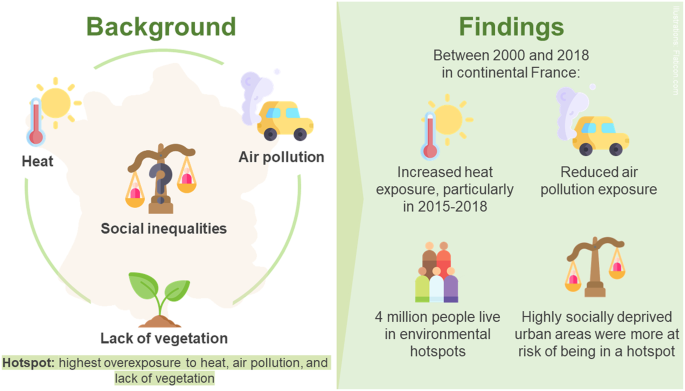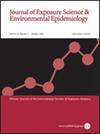Environmental and social inequities in continental France: an analysis of exposure to heat, air pollution, and lack of vegetation
IF 4.1
3区 医学
Q2 ENVIRONMENTAL SCIENCES
Journal of Exposure Science and Environmental Epidemiology
Pub Date : 2024-01-26
DOI:10.1038/s41370-024-00641-6
引用次数: 0
Abstract
Cumulative environmental exposures and social deprivation increase health vulnerability and limit the capacity of populations to adapt to climate change. Our study aimed at providing a fine-scale characterization of exposure to heat, air pollution, and lack of vegetation in continental France between 2000 and 2018, describing spatiotemporal trends and environmental hotspots (i.e., areas that cumulate the highest levels of overexposure), and exploring any associations with social deprivation. The European (EDI) and French (FDep) social deprivation indices, the normalized difference vegetation index, daily ambient temperatures, particulate matter (PM2.5 and PM10), nitrogen dioxide, and ozone (O3) concentrations were estimated for 48,185 French census districts. Reference values were chosen to characterize (over-)exposure. Hotspots were defined as the areas cumulating the highest overexposure to temperature, air pollution, and lack of vegetation. Associations between heat overexposure or hotspots and social deprivation were assessed using logistic regressions. Overexposure to heat was higher in 2015–2018 compared with 2000–2014. Exposure to all air pollutants except for O3 decreased during the study period. In 2018, more than 79% of the urban census districts exceeded the 2021 WHO air quality guidelines. The evolution of vegetation density between 2000 and 2018 was heterogeneous across continental France. In urban areas, the most deprived census districts were at a higher risk of being hotspots (odds ratio (OR): 10.86, 95% CI: 9.87–11.98 using EDI and OR: 1.07, 95% CI: 1.04–1.11 using FDep). We studied cumulative environmental exposures and social deprivation in French census districts. The 2015–2018 period showed the highest overexposure to heat between 2000 and 2018. In 2018, the air quality did not meet the 2021 WHO guidelines in most census districts and 8.6 million people lived in environmental hotspots. Highly socially deprived urban areas had a higher risk of being in a hotspot. This study proposes for the first time, a methodology to identify hotspots of exposure to heat, air pollution, and lack of vegetation and their associations with social deprivation at a national level.


法国大陆的环境和社会不平等:对暴露于高温、空气污染和缺乏植被的分析。
背景:累积的环境暴露和社会贫困增加了健康脆弱性,限制了人口适应气候变化的能力:我们的研究旨在提供2000年至2018年间法国大陆暴露于高温、空气污染和植被缺乏的精细特征,描述时空趋势和环境热点(即过度暴露累积水平最高的地区),并探索与社会贫困的任何关联:方法:估算了 48 185 个法国人口普查区的欧洲(EDI)和法国(FDep)社会贫困指数、归一化差异植被指数、日环境温度、颗粒物(PM2.5 和 PM10)、二氧化氮和臭氧(O3)浓度。我们选择了参考值来描述(过度)暴露的特征。热点地区被定义为气温、空气污染和植被缺乏等过度暴露累积最高的地区。采用逻辑回归法评估了高温暴露过度或热点地区与社会贫困之间的关系:与 2000-2014 年相比,2015-2018 年的高温暴露程度更高。在研究期间,除臭氧外,其他空气污染物的暴露量均有所下降。2018年,超过79%的城市普查区超过了2021年世界卫生组织空气质量指南。2000 年至 2018 年间,法国大陆各地植被密度的变化各不相同。在城市地区,最贫困的人口普查区成为热点的风险较高(使用 EDI 的赔率(OR):10.86,95% CI:9.87-11.98;使用 FDep 的赔率:1.07,95% CI:1.04-1.11):我们研究了法国人口普查区的累积环境暴露和社会贫困状况。2015-2018 年期间,2000 年至 2018 年间的热量过度暴露程度最高。2018 年,大多数普查区的空气质量不符合 2021 年世界卫生组织的指导方针,860 万人生活在环境热点地区。社会高度贫困的城市地区处于热点地区的风险更高。本研究首次提出了一种方法,用于在全国范围内识别暴露于高温、空气污染和植被缺乏的热点地区及其与社会贫困的关联。
本文章由计算机程序翻译,如有差异,请以英文原文为准。
求助全文
约1分钟内获得全文
求助全文
来源期刊
CiteScore
8.90
自引率
6.70%
发文量
93
审稿时长
3 months
期刊介绍:
Journal of Exposure Science and Environmental Epidemiology (JESEE) aims to be the premier and authoritative source of information on advances in exposure science for professionals in a wide range of environmental and public health disciplines.
JESEE publishes original peer-reviewed research presenting significant advances in exposure science and exposure analysis, including development and application of the latest technologies for measuring exposures, and innovative computational approaches for translating novel data streams to characterize and predict exposures. The types of papers published in the research section of JESEE are original research articles, translation studies, and correspondence. Reported results should further understanding of the relationship between environmental exposure and human health, describe evaluated novel exposure science tools, or demonstrate potential of exposure science to enable decisions and actions that promote and protect human health.

 求助内容:
求助内容: 应助结果提醒方式:
应助结果提醒方式:


